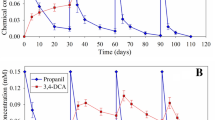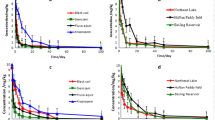Abstract
Pretilachlor and safener fenclorim are the main components of herbicides widely applied to control weeds. Although some pure cultures of bacteria and fungi which degraded these compounds under aerobic conditions were isolated, no isolated pretilachlor- and fenclorim-degrading bacterial strains under anaerobic condition had been available. In this study, the degradation of these compounds and the effects of them on bacterial community structures were investigated under anaerobic conditions. The dissipation rates of pretilachlor and fenclorim in slurries were in the order: soil from paddy field ≈ sediment from river > sediment from mangrove. Moreover, three pretilachlor-degrading bacterial strains (Pseudomonas sp. Pr1, Proteiniclasticum sp. Pr2 and Paracoccus denitrificans Pr3) and two fenclorim-degrading strains (Dechloromonas sp. Fe1 and Ralstonia pickettii Fe2) isolated from a slurry of paddy soil utilized the substrates as sole carbon and energy sources under anaerobic conditions. The degradation of pure pretilachlor and fenclorim at various concentrations by corresponding mixed pure cultures followed the Michaelis–Menten model, with the maximum degradation was 3.10 ± 0.31 µM/day for pretilachlor, and 2.08 ± 0.18 µM/day for fenclorim. During the degradation, 2-chloro-N-(2,6-diethylphenyl) acetamide and 2,6-dimethylaniline were produced in pretilachlor degradation, and benzene was a product of fenclorim degradation. The synergistic degradation of both substrates by all isolated bacteria reduced the metabolites concentrations accumulated in media. This study provides valuable information on effects of pretilachlor and fenclorim on bacterial communities in soil and sediments, and degradation of these substrates by isolated bacteria under anaerobic condition.




Similar content being viewed by others
Data availability
No datasets were generated or analysed during the current study.
References
APHA (2005) Standard methods for the examination of water and wastewater, 21st edn. American Public Health, Washington, DC
Bhardwaj L, Kumar D, Singh U, Joshi C, Dubey S (2024) Herbicide application impacted soil microbial community composition and biochemical properties in a flooded rice field. Sci Total Environ 914:169911. https://doi.org/10.1016/j.scitotenv.2024.169911
Bhowmick S, Das R, Das AC (2014) Effect of thiobencarb and pretilachlor on microorganisms in relation to mineralization of C and N in the Gangetic alluvial soil of West Bengal. Environ Monit Assess 186(10):6849–6856. https://doi.org/10.1007/s10661-014-3893-4
Chau ND, Sebesvari Z, Amelung W, Renaud FG (2015) Pesticide pollution of multiple drinking water sources in the Mekong Delta, Vietnam: evidence from two provinces. Environ Sci Pollut Res Int 22(12):9042–9058. https://doi.org/10.1007/s11356-014-4034-x
Duc HD, Thuy NTD, Truc HTT, Nhu NTH, Oanh NT (2020) Degradation of butachlor and propanil by Pseudomonas sp. strain But2 and Acinetobacter baumannii strain DT. FEMS Microbiol Lett 367(18):151. https://doi.org/10.1093/femsle/fnaa151
Duc HD, Thuy NTD, Thanh LU, Tuong TD, Oanh NT (2021) Degradation of diuron by a bacterial mixture and shifts in the bacterial community during bioremediation of contaminated soil. Curr Microbiol 79(1):11. https://doi.org/10.1007/s00284-021-02685-5
Duc HD, Oanh NT, Khanh NTM (2023) Thiobencarb degradation by Pseudomonas sp. Th1 and Cupriavidus oxalaticus Th2 isolated from soil. Curr Microbiol 80(11):342. https://doi.org/10.1007/s00284-023-03456-0
Fajardo FF, Takagi K, Usui K (2000) Dissipation of mefenacet and pretilachlor in paddy soils under laboratory oxidative and reductive conditions. J Weed Sci Tech 45(4):250–253. https://doi.org/10.3719/WEED.45.250
Hashemi B, Salehian H, Rezvani M, Soltani S (2023) The biological properties of rice paddy fields in different depths affected by pretilachlor herbicide. J Soil Sci Plant Nutr 23:5827–5839. https://doi.org/10.1007/s42729-023-01442-w
Hu L, Yao Y, Cai R, Pan L, Liu K, Bai L (2020) Effects of fenclorim on rice physiology, gene transcription and pretilachlor detoxification ability. BMC Plant Biol 20(1):100. https://doi.org/10.1186/s12870-020-2304-y
Jiang J, Chen Y, Yu R, Zhao X, Wang Q, Cai L (2016) Pretilachlor has the potential to induce endocrine disruption, oxidative stress, apoptosis andimmunotoxicity during zebrafish embryo development. Environ Toxicol Pharmacol 42:125–134. https://doi.org/10.1016/j.etap.2016.01.006
Kanda T, Srivastava R, Yadav S, Singh N, Prajapati R, Singh PK, Yadav S, Atri N (2023) Pretilachlor-induced physiological, biochemical and morphological changes in Indian paddy field agroecosystem inhabited Anabaena doliolum. Environ Res 238:117201. https://doi.org/10.1016/j.envres.2023.117201
Kaur P, Kaur P, Bhullar MS (2015) Persistence behaviour of pretilachlor in puddled paddy fields under subtropical humid climate. Environ Monit Assess 187(8):524. https://doi.org/10.1007/s10661-015-4756-3
Kobayashi K, Ashida N, Shim IS (1999) Pretilachlor behavior and its phytotoxic activity on transplanted rice in Utsunomiya paddy soil. J Weed Sci Tech 44:285–292. https://doi.org/10.3719/WEED.44.285
Kwatra N, Abraham J (2023) Biomineralization of pretilachlor by free and immobilized fungal strains isolated from paddy field. Arch Microbiol 205(5):188. https://doi.org/10.1007/s00203-023-03538-4
Lamberth C (2016) Chloroacetamide herbicides. In Bioactive Carboxylic Compound Classes (eds C. Lamberth and J. Dinges):293–302.
Liu J, Brazier-Hicks M, Edwards R (2009) A kinetic model for the metabolism of the herbicide safener fenclorim in Arabidopsis thaliana. Biophys Chem 143(1–2):85–94. https://doi.org/10.1016/j.bpc.2009.04.006
Liu J, Zhang X, Xu J, Qiu J, Zhu J, Cao H, He J (2020) Anaerobic biodegradation of acetochlor by acclimated sludge and its anaerobic catabolic pathway. Sci Total Environ 748:141122. https://doi.org/10.1016/j.scitotenv.2020.141122
Liu H-m, Yuan M, Liu A-m, Ren L, Zhu G-p, Sun L-n (2021) A bifunctional enzyme belonging to cytochrome P450 family involved in the O-dealkylation and N-dealkoxymethylation toward chloroacetanilide herbicides in Rhodococcus sp. B2. Microb Cell Factories 20:61. https://doi.org/10.1186/s12934-021-01544-z
Mahanta K, Bhattacharyya PN, Sharma AK, Rajkhowa D, Lesueur D, Verma H, Parit R, Deka J, Medhi BK, Kohli A (2023) Residue and soil dissipation kinetics of chloroacetanilide herbicides on rice (Oryzae sativa L.) and assessing the impact on soil microbial parameters and enzyme activity. Environ Monit Assess 195:910. https://doi.org/10.1007/s10661-023-11513-1
Marin-Morales MA, Ventura-Camarg BC, Hoshin MM (2013) Toxicity of herbicides: impact on aquatic and soil biota and human health. Herbicides Andrew Price, IntechOpen 399–443. https://doi.org/10.5772/55851
Oloye FF, Femi-Oloye OP, Challis JK, Jones PD, Giesy JP (2021) Dissipation, fate, and toxicity of crop protection chemical safeners in aquatic environments. Rev Environ Contam Toxicol 258:27–53. https://doi.org/10.1007/398_2021_70
RajaRajeswari R, Sathiyanarayanan S, Ramesh A, Ayyappan S (2013) Evaluation of bioavailability of residues of pretilachlor in soil and water under paddy cropping condition and their influence on Lemna gibba. J Agric Environ 14:102–110. https://doi.org/10.3126/AEJ.V14I0.19790
Saha S, Dutta D, Karmakar RDP (2012) Structure–toxicity relationship of chloroacetanilide herbicides: relative impact on soil microorganisms. Environ Toxicol Pharmacol 34:307–314. https://doi.org/10.1016/j.etap.2012.04.014
Sahoo S, Adak T, Bagchi TB, Kumar U, Munda S, Saha S, Berliner J, Jena M, Mishra BB (2016) Non-target effects of pretilachlor on microbial properties in tropical rice soil. Environ Sci Pollut Res 23:7595–7602. https://doi.org/10.1007/s11356-015-6026-x
Sapari P, Ismail BS (2012) Pollution levels of thiobencarb, propanil, and pretilachlor in rice fields of the muda irrigation scheme, Kedah, Malaysia. Environ Monit Assess 184(10):6347–6356. https://doi.org/10.1007/s10661-011-2424-9
Soni R, Verma S (2018) Acute toxicity and behavioural responses in Clarias batrachus (Linnaeus) exposed to herbicide pretilachlor. Heliyon 4:e01090. https://doi.org/10.1016/j.heliyon.2018.e01090
Toan PV, Sebesvari Z, Blasing M, Rosendahl I, Renaud FG (2013) Pesticide management and their residues in sediments and surface and drinking water in the Mekong Delta. Vietnam Sci Total Environ 452–453:28–39. https://doi.org/10.1016/j.scitotenv.2013.02.026
Vidotto F, Ferrero A, Bertoia O, Gennari M, Cignetti A (2004) Dissipation of pretilachlor in paddy water and sediment. Agronomie 24:473–479. https://doi.org/10.1051/agro:2004043
Zhang J, Zheng JW, Liang B, Wang CH, Cai S, Ni YY, He J, Li SP (2011) Biodegradation of chloroacetamide herbicides by Paracoccus sp. FLY-8 in vitro. J Agr Food Chem 59:4614–4621. https://doi.org/10.1021/jf104695g
Acknowledgements
The authors are thankful to Dong Thap University for providing the instrumental facility. We are grateful to the anonymous reviewers and editors, whose suggestions helped to improve this manuscript.
Funding
This research is funded by Vietnam National Foundation for Science and Technology Development (NAFOSTED) under grant number 106.04-2021.63. The authors would like to thank them for all supports.
Author information
Authors and Affiliations
Contributions
HDD designed the experiments, performed the experiments on bacterial isolation and wrote the manuscript. NTO performed the experiments on biodegradation. NTDT and NTKX assisted the experiments.
Corresponding authors
Ethics declarations
Conflict of interest
The authors declare that they have no competing interests.
Ethical approval
This research does not involve human participants and/or animals.
Informed consent
Not applicable.
Additional information
Publisher's Note
Springer Nature remains neutral with regard to jurisdictional claims in published maps and institutional affiliations.
Supplementary Information
Below is the link to the electronic supplementary material.
Rights and permissions
Springer Nature or its licensor (e.g. a society or other partner) holds exclusive rights to this article under a publishing agreement with the author(s) or other rightsholder(s); author self-archiving of the accepted manuscript version of this article is solely governed by the terms of such publishing agreement and applicable law.
About this article
Cite this article
Duc, H.D., Oanh, N.T., Dieu Thuy, N.T. et al. Degradation of pretilachlor and fenclorim and effects of these compounds on bacterial communities under anaerobic condition. Biodegradation (2024). https://doi.org/10.1007/s10532-024-10078-1
Received:
Accepted:
Published:
DOI: https://doi.org/10.1007/s10532-024-10078-1




